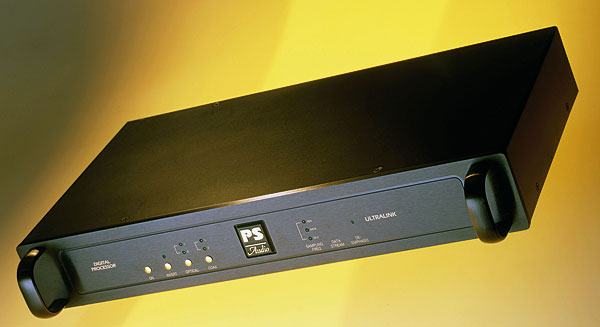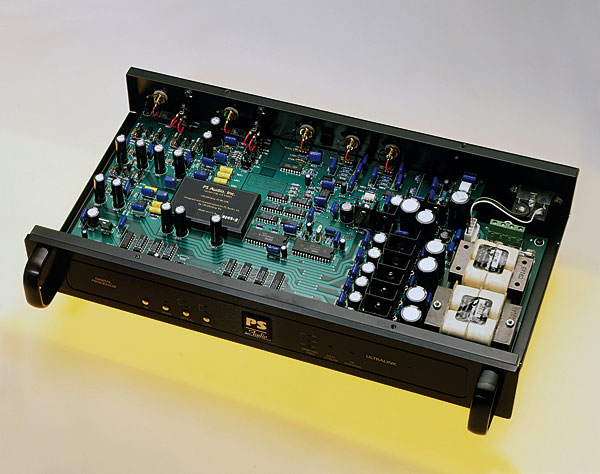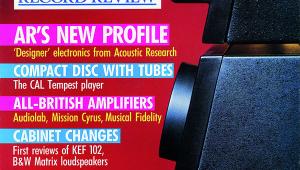Enlightened or Ultralink? Page 2
PS Audio has worked on a series of digital decoders while its main claim to fame is its latest model using a costly 20-bit Ultra Analog stereo D/A converter. Until recently, this device had only been used in some expensive decoders, such as the big Stax and the Levinson Model 30.
The Ultralink is a neatly presented unit and in terms of versatility and features is reminiscent of the British Audiolab 8000DAC converter. From the front panel it may be seen that it remains permanently in standby and there is no power switch for the mains supply. Meanwhile, the Ultralink offers four digital inputs: one Toslink optical, with a second optional AT&T optical (easily retrofitted when needed) and two coaxials. Other facilities include absolute phase inversion.
Indicators show which prime sampling rate is operating: 32, 44.1 or 48kHz; whether clean digital data is locked on; and finally whether the source has de-emphasis active. A final LED shows if the unit is on irrespective of the condition of the other lamps, whose states must be initialised when power is first connected. The audio output is at fixed level and is available from high quality phono sockets or in balanced form via XLR terminals.
A well fitted chassis has exposed terminals at mains potential on the back of the input filter/IEC socket; the exposed fuse is also at mains potential. After that gripe for the benefit of service technicians, we come to two PC-mounted mains transformers with full isolation maintained between primary and secondary. Three rectifier bridges feed a total of nine IC regulators. Extensive subsidiary decoupling is provided at every stage.

After signal conditioning and logic selection the digital signal is unscrambled from the serial S/PDIF code in the Yamaha YM3623 chip. The audio data go directly to the NPC SM5803 high-order digital filter, 8x oversampled, and de-emphasis is done in the digital domain. With a 20-bit output code, to maximise the 16-bit theoretical resolution, the signal goes straight through to the selected Ultra Analog dual 20-bit ladder-type or multibit converter; this is laser trimmed and calibrated to a very high accuracy. Post filtering is carried out in a pair of JRC 5532 integrated circuits.
Hybrid Drive
The balanced output amplifiers are hybrids, four complementary push-pull output transistors driven by a JRC 5534. Thus there are four of these units to provide the two phases for two channels. One phase goes to the RCA phono socket, the full balanced signal being available on XLR sockets. The build quality is high, promising a long life, though I do think PS Audio should consider fitting rather quieter transformers for our 50Hz, 240V supplies.
![]() Clear To Hear
Clear To Hear
Enjoying the same test conditions as the DSP7000, areas addressed here included mains supply and cable, and the digital link cable. A selection of transports were used – Meridian's 200 and 602, and an Accuphase DP70-V – while control units included the Krell KSP-7B and Conrad Johnson PF1, a passive P&G potentiometer, and the current Audio Synthesis PAS-02. An ultimate, if impractical, fixed-gain link was achieved using a resistive attenuator in the balanced link to the power amplifiers, which were a Krell KSA-150B and Meridian 605.
So far my findings for balanced mode are inconclusive. Only where poor local or mains supply electrical noise levels are present does there seem to be a significant advantage to balanced working. Comparison decoders included the relevant section on the DP70-V, the Enlightened Audio DSP7000 and the Micromega Duo BSII, while experience from recent trials of the Theta, Roksan and Linn digital products was also brought to bear.
From the start it was clear that this was a great performer, which could claim membership of that elite US high-end group despite a modest cost. It sounded very clean, with excellent transparency and high resolution. This was distributed evenly over the frequency range and was not limited to the exceptionally focused and articulate midrange.

Grand Slam
The bass went deep, reminding one of the real contribution that weight and controlled slam can make to a system capable of handling it. The upper bass reflected the mid quality, showing a combination of fine harmonic and textural detail. This was particularly apparent with Wilson Audio speakers, which are themselves unusually revealing in the upper bass/lower mid. The Ultralink treble was also good, if very slightly softened and rounded, being not quite as crisp and explicit as it could have been. An almost inaudible haze was present, though this generally went unnoticed. Sibilants were reproduced extremely well, the usual careless lisp and splash heard with many digital products being absent, even if the presentation was slightly dulled in the extreme treble.
A trace of electronic hardness could be heard in the upper mid: this was somewhat dependent on the choice of system and cable used. When the going got rough, the PS decoder lost some of its elegant composure, and showed mild coarsening and thickening of texture in the midrange. Dynamics were very good, this unit sounding expressive with an exciting range of soft/loud contrasts and showing an uncompressed character on lively, high-level transients. Soundstages were well focused and stable, with the image having good depth, natural perspectives and fine width.

As far as 'timing' was concerned, the PS Audio Ultralink fell below its otherwise high standard. It rated 'average plus' for the rendition of 'pace and rhythm' in well known recordings. However, this was more than satisfactory for many high-quality systems, and many listeners would testify that this sonic parameter is not too important. Rhythm enthusiasts must confirm this aspect for themselves. Taking an overall view and balancing all aspects, the digital replay closely approaches that of my present reference, the Accuphase DP70-V.
Conclusion
PS Audio has been successful with this decoder design. The Ultralink is a genuine high-end product which has jumped ahead of designs from many famous names to appear close to the current leading edge of digital replay, in company with specialist operators such as Theta, Micromega, and Accuphase.


















































